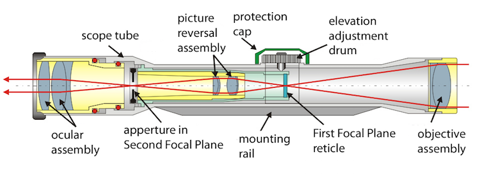Riflescopes: A Glossary
Posted by Cory Ross on Jun 13th 2024

There is a lot of misinformation when it comes to optics. Some time ago, I sat down and wrote a series of articles titled “Optics 101.” This series aimed to break myths and educate the audience on the ins and outs of optics, specifically riflescopes (the articles are as follows, “Christmas Trees and BDCs,” “MIL vs. MOA,” “Executing the Objective”). In that time, optics have continued to advance and have become increasingly popular. Long-range shooting is still all the rage which means precision optics are popular. Conversely, “Low-Powered-Variable-Optics” (LPVO) have hit their stride when it comes to performance and availability and many consumers are adorning their AR-style rifles (or hunting rifles, lever guns, or just about anything that can have an optic affixed to it) with them. So, in the spirit of those past articles, I’ve created a glossary of terms for riflescopes (note, a later article will be published covering red dots, specifically the ones designed for pistols).
Glossary (From A-Z)
Aberration:Aberration is the failure of light rays to converge at one focus point because of limitations or defects in a lens. When light hits the first lens of a riflescope, the light begins to bend and refract in undesirable ways. A good scope uses tools to fix the aberration to create a clear, bright target picture.
Ballistic Solver:Common solvers include Applied Ballistics, Hornady 4DOF, and the Shooter App—all of which can be found in the app store on your smart device. These calculate the bullet’s flight path and predict holdovers based on the information inputted.
Bullet Drop Compensating (BDC):Our idea of BDC reticles debuted in the mid-2000s when Nikon popularized the concept. A BDC reticle has holdover points along the vertical axis that represent various distances. The center of the crosshair usually starts at 100 yards (though that isn’t always true). Essentially, if your target is 300 yards away and you are shooting a standard cartridge—say 308 for example—the user holds the reticle on the second BDC point. This system worked well enough that Nikon released volumes of scopes in different configurations to fit a variety of applications (predator, tactical, and rimfire). Now nearly every manufacturer is offering something similar. However, the reticle is not without faults. The primary issue is the reticle is fixed in the second focal plane. This means that the reticle can only be used at a fixed magnification, usually the maximum power (depending on the manufacturer) of the optic (unless you are a math whiz and can calculate the holdover points as magnification is changed). BDCs are a fixed solution and changes in parameters such as caliber, temperature, and elevation cannot be easily done. Ballistic calculators can be used to “adjust” the holdover points, but that removes the ease of 100, 200, 300, and so forth yard points. For the average whitetail hunter in Ohio where shots are regularly taken under 200 yards, a BDC reticle can be a fine solution to aid the hunter.
Christmas Tree Reticles:An advanced reticle that allows the user to hold over for elevation and wind based on the ballistic data provided by ballistic solvers. These solvers use the ballistics of the shooter’s cartridge combined with environmental data input by the shooter (or drawn from something like a Kestral weather meter). These reticles are found in FFP optics; therefore, the holds remain constant at any magnification setting. (Do note, at low magnification, the reticle will be nearly impossible to discern). FFP reticles can be advantageous both on the firing line and in the field. As waves are made in the long-range competition, those products and techniques are translating over to hunting, with even new classes of shooting competitions created to mimic field conditions, i.e. NRL Hunter division.
Custom Dial System (CDS):This is Leupold’s response to Nikon’s and other manufacturers’ BDC reticle. Leupold applies the user’s ballistics and environmental information into a solver and then etches an elevation turret with yard increments. The benefit, the turret adjustments are not impacted by the optic’s magnification. Turrets are constant, therefore fixing an adherent problem with a BDC reticle. Still, if a shooter wants to switch calibers or goes from hunting deer in Ohio to an Elk hunt in Colorado, the elevation impact will drastically change the dialing, thus a new turret will be needed.
Duplex:A reticle where the vertical and horizontal stadia intersect. The stadia are usually thicker on the edges and step down in size as they approach the center.
Elevation and Windage:The adjustment knobs on modern sporting optics. In modern optics, the lines don’t move independently of each other, but rather, move in a grid-like pattern.
Erector:the system forward of the eyepiece to the turrets.
Eye Relief: The fixed distance from the ocular lens at which the user’s eye can see the full field of view. The image quality will be stunted if the optic is too close or too far away,
Eyepiece:the rear portion of the optic that the user looks through. This is also the home focus adjustment for the reticle.
Exit Pupil: Exit pupil equals the objective bell diameter divided by its magnification. For example, on a 3-9x40 with the magnification set at its highest power, the exit pupil is 4.44mm.
The exit pupil of a scope directly impacts the perceived brightness of an image by the human eye. It is a relationship between the scope and the size of a person’s pupil. A human eye’s pupil in low light can grow from 3mm to 7mm. However, in the daytime, the human eye’s pupil narrows to an average of 2.5mm when looking through a scope to find targets hidden in shadowy vegetation. The better a scope can match the pupil of the eye, the brighter and more defined an image appears. Therefore, the large exit pupil created by a large objective bell will not always create a brighter image because a human’s pupil cannot grow to match it (on a nice sunny day for instance).
In this instance, the aberration created by an objective bell may be a hindrance, unless it’s a scope that has the correct lenses and coating to fix the problem. The downside here is cost. Having a large scope with high magnification and a large objective bell that has exceptional optical clarity are expensive (generally over $2,000)
Exit pupil matters most at twilight and when shooting fast. At low light, the goal is to have an exit pupil match the eye’s pupil (remember, the eye’s pupil increases as daylight wanes). This will allow the eye to use all the available light transmitted by the scope. However, having a big objective bell doesn’t always offset the negatives. Having a scope with a moderate magnification range and objective size while dialing down magnification will increase the exit pupil and maintain good optical quality and image brightness while matching the eye’s pupil. When shooting fast, like 3-gun for instance, dialing down in magnification helps your eye transition from target to target. A better exit pupil gives the human eye leeway when trying to focus as the shooter moves.
Field of View (FOV): The width of the area you can see when looking through an optic. The higher the magnification, the lower the FOV. Conversely, the lower the magnification, the wider the FOV.
Focal Plane:The reticle of an optic can be placed in two different focal planes—one forward of the turret assembly and one rearward. A reticle in the rear focal plane (also called second focal) maintains a constant size while moving up and down the magnification range. Front focal optics—or the first focal plane—have reticles that increase and decrease in size proportionally as the magnification increases and decreases.
Illuminated Reticle:As the name states, the entire, or partial reticle is illuminated. While not ideal in bright conditions, illumination is better suited against a dark background.
Minute of Angle (MOA): A circle is 360 degrees with each degree divided into 60 minutes. Therefore, each circle is made up of 21,600 minutes. At a hundred yards, 1-degree measures 62.83 inches. One MOA then—1/60 of that—is 1.047 inches. Normally, MOA is rounded down to an even 1 inch. For most shooting, using the approximation is fine. For example, at 1000 yards 1 MOA is approximately 10 inches. The exact is 10.47 inches—a negligible difference.
Milliradians (MIL): A common misunderstanding involving MILs is that it is a metric-only system. This is not completely true. A radian is a metric form of angular measure dividing radians in a circle. Moreover, Milli means 1/1000, so 1 milliradian is 1/1000 of a radian. Additionally, one radian equals 57.3 degrees—360 degrees divided by 57.3 equals 6.2832 MILs in a circle. There are 1,000 MILs in 1 radius and 6,2382 MILs in a circle. MILs are then divided into tenths for precise measurement. At 100 hundred yards 1 MIL is 3.6” and .1 MIL is .36”. At 100 meters 1 MIL is 10 centimeters and .1 MIL is 1 centimeter. 1 MIL at a thousand yards equals one yard and 1 MIL at a thousand meters equals one meter. MILs may be a metric unit of measure, but the systems work with standard and metric units.
Mils can also be used for range estimation. The formula is as follows: Range (or distance to target) = size of target / MILs. If you know the approximate size of your target, then you can calculate a rough range.
Objective:the portion of a scope forward of the turrets. The lens in the objective bell takes the incoming light and focuses it down to the first focal plane. Its size does not correlate to “light gathering” or image resolution (see exit pupil).
Zero Set: The ability to lock in a fixed zero distance on the optic once it is sighted in. This allows for easy return-to-zero after dialing for longer ranges. This is ideal for precision or long-range optics.














